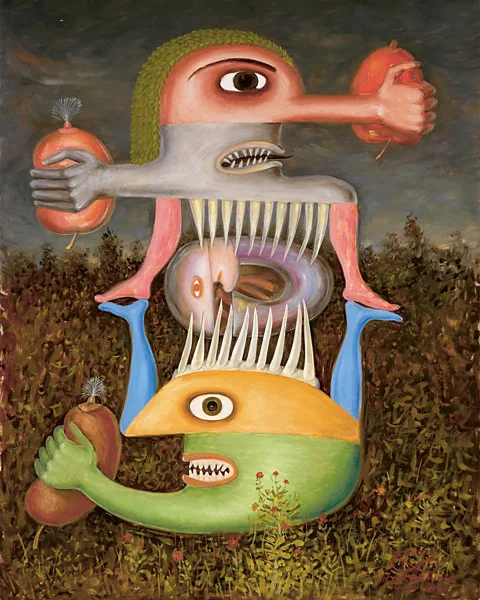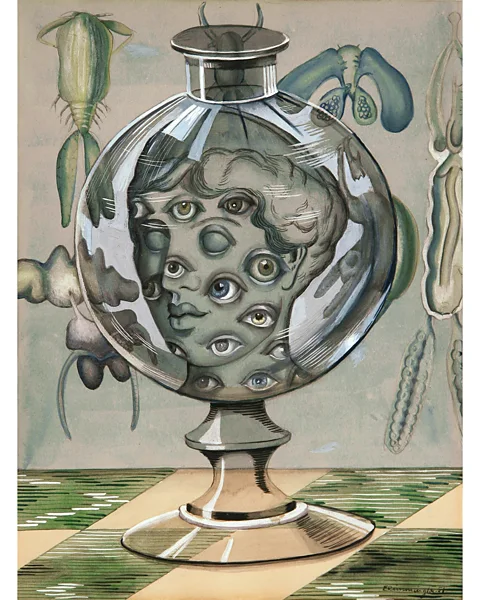These five bizarre Surrealist artworks are not what they seem
-
Ivan Brown
- Estimated read time 4 min read
- November 15, 2024
Surrealism, often dismissed as trivial or nonsensical, was in fact deeply shaped by the trauma of living through fascism and the devastating aftermath of war. This century-old movement, born out of the disillusionment with rational thought after the chaos of World War I, aimed to challenge conventional notions of reality and logic. André Breton’s Manifesto of Surrealism (1924) called for a “mode of pure expression” driven by the subconscious, free from the constraints of reason. Despite its initial emphasis on writing, Surrealism soon found its visual voice with the first Surrealist art exhibition in 1925 in Paris, showcasing dreamlike works by artists such as Joan Miró, Pablo Picasso, Man Ray, and Max Ernst.
 Totem of Wounded Subjectivity II by Victor Brauner (1948) (Credit: VG Bild-Kunst Bonn 2024/ Centre Pompidou)
Totem of Wounded Subjectivity II by Victor Brauner (1948) (Credit: VG Bild-Kunst Bonn 2024/ Centre Pompidou)
The art that emerged from this period is often whimsical or outlandish—think of Salvador Dalí’s melting clocks or Méret Oppenheim’s furry teacup. However, as exhibitions marking the centenary of Breton’s manifesto reveal, Surrealist art was profoundly influenced by the horrific realities of war and fascism. As co-curator Stephanie Weber of the Lenbachhaus in Munich points out, Surrealism emerged at the same time as fascist movements across Europe, and many artists in the movement were actively resisting these regimes, either through exile or direct involvement in resistance efforts.
One such artist was Romanian Jewish painter Victor Brauner, who fled Nazi-occupied Europe in the 1940s. His Totem of Wounded Subjectivity II (1948), a striking oil painting of surreal, cartoonish figures that blend elements of humor and menace, illustrates the complex interplay between absurdity and suffering. His work combines surrealist motifs, such as the egg symbolizing new possibilities, with a haunting, visceral quality that speaks to the trauma of his time.

Personal Values by René Magritte (1957) (Credit: San Francisco Museum of Modern Art/ Katherine Du Tiel/ Adagp, Paris, 2024)
In Paris, the Pompidou Centre’s expansive exhibition features works like René Magritte’s Personal Values (1957), which plays with the scale of everyday objects to create a disorienting, yet comedic atmosphere. But beneath this humor lies a deep critique of the rational thinking that led to the horrors of war. Surrealists such as Magritte sought to free the mind from the constraints of reason and tap into the subconscious, where dreams and irrationality could reshape reality.

Hand-Shell by Dora Maar (1934) (Credit: Centre Pompidou, MNAM-CCI/Jacques Faujour/ Dist RMN-GP/ Adagp, Paris, 2024)
Surrealism also highlights the often-overlooked contributions of female artists. The Pompidou exhibition showcases works by women like Leonora Carrington, Dorothea Tanning, and Dora Maar, who were frequently relegated to the role of muses but whose works were vital in shaping the movement. Maar’s Hand-Shell (1934), for instance, juxtaposes elegant and unsettling imagery, invoking a sense of both creation and destruction—perhaps a commentary on the birth of a new world amid the ruins of the old.

Museum by Edith Rimmington (1951) (Credit: Courtesy of the Murray Family Collection (UK & USA/ Chris Harrison / Estate of Edith Rimmington)
In the UK, the Traumatic Surreal exhibition at the Henry Moore Institute delves into the work of female surrealists who used art to express the painful legacies of fascism and war. As co-curator Patricia Allmer notes, the experiences of these artists—often victims of patriarchal values and war trauma—led them to depict disturbing, visceral images of violence and decay. One standout work is Squirrel (1969) by Méret Oppenheim, which contrasts the playful, tactile texture of fur with the violence implied by the severed tail of the animal. Oppenheim’s art, like much of the surrealist female oeuvre, uses humor and shock to address the unspoken traumas of history.

Squirrel by Méret Oppenheim (1969) (Credit: Courtesy of LEVY Gallery, Hamburg/Berlin)
Through humor, the Surrealists offered a way to cope with the distressing realities of the world. André Breton himself wrote that humor is a necessary tool for “brushing reality aside when it gets too distressing.” While the playful elements of Surrealist art are often what attract attention, they also serve as a means to process the violence and chaos of the era, allowing artists to confront the unimaginable without being overwhelmed.
Surrealism, then, is not just a celebration of the absurd, but a powerful, complex response to the pain and disillusionment of its time, offering both a critique of society and a new lens through which to view the world.